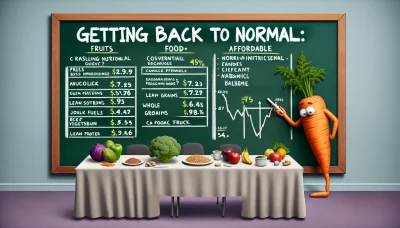Frugal Grocery Shopping Tips Quiz
Test Your Knowledge
Question of
Frugal Grocery Shopping Tips for Healthy Eating
Maintaining a balance between frugality and healthy eating is essential for both physical well-being and financial health. It's a misconception that eating healthily always comes with a high price tag. By adopting smart shopping strategies, such as buying in-season produce, utilizing coupons, and focusing on whole foods rather than processed items, individuals can enjoy nutritious meals without overspending. This approach not only supports a healthier lifestyle but also promotes sustainable eating habits by reducing waste and encouraging the consumption of local and seasonal foods.
Planning Your Grocery List
Creating a grocery list before heading to the store is more than just a way to remember what to buy. It's a strategic tool that can help you save money and make healthier eating choices. By taking the time to plan your meals and snacks for the week, you can avoid impulse purchases that often lead to overspending and unhealthy eating. Moreover, a well-thought-out grocery list ensures that you buy exactly what you need, reducing food waste and helping you stick to your budget. In essence, the act of planning and list-making is a cornerstone of savvy shopping and nutritious living.
Seasonal Shopping and Savings
Purchasing seasonal produce is not only a cost-effective approach to grocery shopping but also significantly beneficial for maintaining a healthy diet. When fruits and vegetables are in season, they are abundant, which typically lowers the cost due to the high supply. Moreover, seasonal produce tends to be fresher and packed with more nutrients compared to off-season counterparts that may have traveled long distances. This means you can enjoy a variety of fresh, flavorful, and nutritious foods throughout the year while also saving money. Embracing seasonal shopping encourages a diverse diet and supports local farmers, making it a win-win for your health and community.
Understanding Food Labels
Reading and understanding food labels is a crucial skill for anyone looking to make healthier and more economical grocery choices. By paying attention to the nutritional information and ingredients list on food packaging, consumers can gain insight into the nutritional value of the food they are considering. This knowledge allows for more informed decisions, helping to balance dietary needs with budget considerations. Understanding food labels can lead to better dietary choices, reducing the intake of unhealthy fats, sugars, and sodium while increasing the consumption of beneficial nutrients. This practice not only supports individual health and well-being but also encourages a more mindful approach to eating and shopping.
Bulk Buying and Its Benefits
Buying in bulk is not just a strategy for saving money; it's a lifestyle change that can lead to more sustainable living. When you purchase items in larger quantities, you're often able to take advantage of lower prices, reducing the overall cost per unit. This means that over time, the initial investment pays off, allowing for significant savings. Moreover, bulk buying often applies to whole foods such as grains, nuts, and legumes, which encourages a shift towards a healthier diet. By having these nutritious ingredients readily available at home, individuals are more likely to cook wholesome meals, contributing to better health and well-being.
Effective Use of Coupons and Discounts
To effectively use coupons and find discounts for saving money on groceries without compromising on eating healthy, start by planning your meals around what's on sale. Prioritize purchasing fresh produce and lean meats that have discounts or coupons available. It’s also beneficial to join loyalty programs at your local grocery stores to receive exclusive deals. Organize your coupons and keep an eye on expiration dates to ensure you use them in time. Additionally, consider using apps and websites that aggregate discounts and digital coupons for further savings. Remember, the goal is to buy nutritious foods at a lower price, not to compromise health for the sake of a discount.
Storing and Preserving Food
Minimizing waste and maximizing the value of your grocery shopping starts with proper food storage and preservation techniques. To ensure longevity and maintain the quality of your food, it's essential to understand the specific storage requirements for different types of food. For instance, fruits and vegetables often require different humidity levels, with some needing refrigeration while others are best kept at room temperature. Dry goods, on the other hand, should be stored in airtight containers in a cool, dark place to prevent them from going stale or attracting pests. Additionally, freezing is an excellent way to preserve the shelf life of many products, from bread to meat and even some dairy products, without sacrificing much in terms of taste or nutritional value. Always remember to label and date your frozen items to keep track of their freshness. By adhering to these best practices, you can significantly reduce food waste and ensure that you are always making the most out of your grocery shopping.












